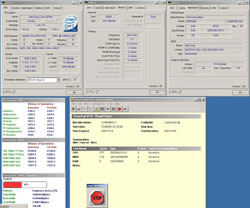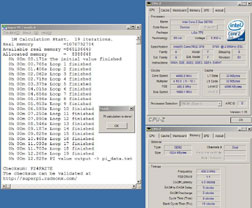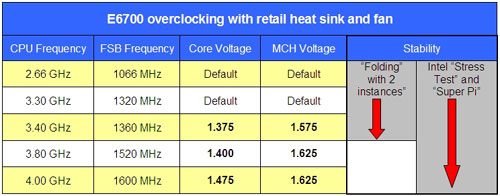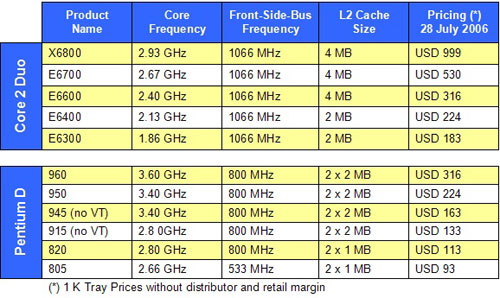|
|
|
|
|
Intel Core 2 Duo "Conroe" CPUs |
|
Join the community - in the OCAU Forums!
|
Overclocking Continued, Summary & Final Thoughts
Overclocking Continued:
With voltage adjustments for CPU and MCH available we started increasing FSB frequency and voltage in small increments. We found that slightly increased voltage helps the memory controller (MCH) run with higher than specified frequencies. By the way, the 975 MCH is by default capable of handling 1333 MHz. Most 975X based boards have this option in their BIOS. Increasing the FSB voltage seems to have no impact. To our surprise the E6700 went up to 10 x 400 MHz = 4.00 GHz. At that point we had reached a “given” limit, because the 975XBX BIOS does not allow to increase the FSB frequency more than 50% above default.
Probably this E6700 sample would have gone even higher. At 4.00 GHz and with the stock heatsink and fan we were able to run the stress test that comes with Intel’s “Desktop Utilities” for 15 minutes and could benchmark with “SuperPi”.
 
4000MHz: StressTest (left) and SuperPi (right)
But the system was not stable enough to run heavy applications. In order to run 2 of Stanford’s “Folding @ Home” console clients (one for each core) we had to scale back the CPU frequency to 3360 MHz. But again: This is with the most primitive cooling available. A high-end 3rd party heatsink and fan would probably give another 100 MHz ~ 200 MHz stable frequency headroom.

Considering the much higher Core 2 Duo per-clock efficiency in comparison with Pentium D an additional gain of 700 MHz under these conditions is a very solid achievement. It shows that Intel will have plenty of headroom to scale Conroe further upward. We guess that Conroe is eventually good for a default speed of around 3600 MHz.
Summary and Final Thoughts:
Thanks to its new micro-architecture, Core 2 Duo is performing far better than the previous generation dual core Pentium D. An X6800, for example, is between 30% ~ to 40% faster than a Pentium D 955XE. Core 2 Duo is achieving performance in applications and games that has not been seen before with a dual core desktop CPU. In addition Core 2 Duo consumes 40% less power and runs much cooler than Pentium D. An additional bonus for many enthusiasts is certainly the solid overclocking headroom we found with both Core 2 Duo test samples.
In February 2006 an Intel engineer was quoted with the claim that a certain new product with the codename Conroe would be at least 20% faster than the fastest AMD offering at the time when it would released in mid 2006. That claim was promptly dismissed by those “in the know” as frivolous marketing talk. Well, the Intel man was right. There is no doubt that Core 2 Duo is indeed, as claimed, substantially outperforming AMD's fastest desktop processor running with DDR2 on the just released AM2 platform. With the exception of memory bandwidth and latency, in none of our 26 tests did the FX-62 come close to the X6800 or E6700. A conservative estimate would be that on average an X6800 (2.93 GHz) is at least 20% faster than the FX-62 (2.80 GHz) and even an E6700 (2.67 GHz) is around 10% faster. We can estimate from our test results that the FX-62, currently AMD’s fastest desktop processor, is approximately performing like an E6600 clocked at 2.40 GHz.
We see Core Duo 2 reigning supreme for some time to come. At the end of 2006 AMD will breathe new air into the Athlon 64 by moving the production process to 65nm technology. This will probably allow them to scale the almost exhausted K8 architecture another 200 MHz or 300 MHz higher. We doubt though that this will be enough to regain the desktop performance crown. Intel will launch higher clocked Core 2 Duo versions as well. And the just launched Conroe core has certainly more headroom left than AMD’s 3-year old K8 design. In addition Intel will probably enable Hyperthreading and will in the first half of 2007 already move to 45nm production technology.
Another interesting question is how the quad-core products announced by both companies will compete against each other. But with the Core micro-architecture it seems Intel will have the better basis for quad-core products as well. A serious challenge to Core 2 Duo will probably not come before AMD introduces their revamped K8L micro-architecture later in 2007. In the meantime AMD will do what Intel has done over the last 2 years: undercutting competitor prices until their products become competitive at a given price point. That will certainly be another positive impact of the Core 2 Duo introduction from the consumer's point of view.
That leaves us with the question of Core 2 Duo prices. Wearing the performance crown is a matter of prestige and good for the brand image. But at the end what matters most for the consumer is value for performance. Intel has announced the following Core 2 Duo wholesale prices to distributors as of July 26.

These wholesale prices are a good indication for the expected retail prices when adding around 15%. Although we have to marvel about the outstanding X6800 performance we think that a processor retailing for more than 1000 USD won't be a popular choice. We expect the E6600 to be the most sought-after Core 2 Duo processor, because it is the cheapest version with 4 MB L2 cache. At an expected price level of around 360 US$ or 480 AUS$ the E6600 would cost less than half of an FX-62, and would deliver the same performance. In addition an E6600 will allow overclocking far above 3 GHz.
To sum it up: Core 2 Duo has regained the performance crown for Intel in spectacular fashion. We have no doubt that Core 2 Duo will be the most popular product for desktop computing well into 2007.
If you're a Digg user and you liked this review, please Digg it!
|
|
Advertisement:
All original content copyright James Rolfe.
All rights reserved. No reproduction allowed without written permission.
Interested in advertising on OCAU? Contact us for info.
|

|


